
views
Getting Started

Calculate and purchase at least the total length of gutters needed, as well as the necessary downspouts and attachment brackets. Gutters should be attached to the fascia and run the entire length of the roof, ending with a downspout. If a gutter run will measure longer than 40 feet (12 m), the gutter should be positioned to pitch down from the middle, aimed toward a downspout at each end. A fascia bracket will be attached to every other rafter tail, or approximately every 32 inches (81 cm). Depending on the type of gutters you want, expect to pay anywhere from $2 to $6 per linear foot for aluminum gutters. Copper gutters could run as much as $20 per linear foot. Expect to pay approximately $2 per linear foot for downspouts, and $6 to $10 each for the brackets that attach the gutters to the fascia.
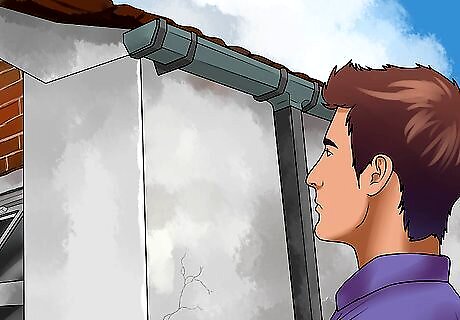
Inspect the fascia and soffit for any rot or decay before moving on to installation. What good will installation be if the fascia holding your gutters up rots away? To inspect the fascia, poke at the ends of fascia boards, or where two ends of fascia boards meet. If it feels spongy or compromised, you may want to consider replacing the fascia before moving on. Think about replacing the fascia with more resistant material, or just sticking with wood. If you believe the rotting is caused by excessive moisture due to ineffective gutters, then wood might acceptable. (You are going to install working gutters, after all). If you believe the rot to be caused by other factors, consider choosing a material like aluminum or vinyl that withstands the elements a bit better than wood.
Planning the Slope of the Gutters
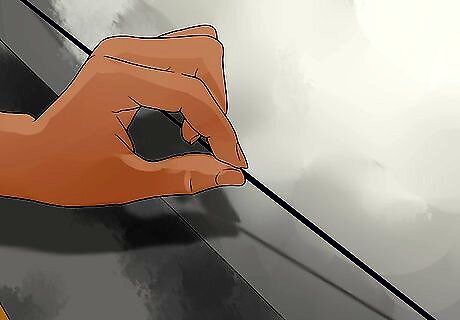
Measure and snap a layout line using a chalk line. You want your gutters to work properly, and in order for them to do that, they need to have a slight downward angle to feed any running water toward the downspout. Longer gutters (35 feet and longer) will slope from the center to each end. They will start at the same height in the middle and tilt downward to the edges, ending at the same point. Shorter gutters should tilt from one end to the other. They should start at a high point and end at a lower point.
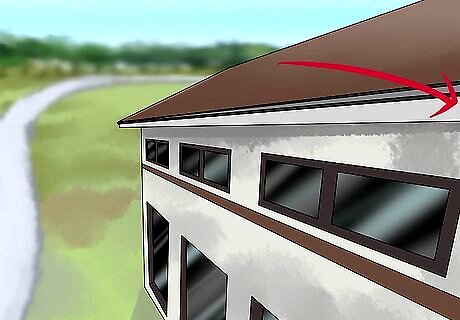
Locate the starting point, or highest point, of the gutter run. If your fascia board is longer than 35 feet (10.6 m), your starting point will be in the center of the fascia board. If it's shorter than 35 feet (10.7 m), your gutter will run from one end to the other. Mark the high point on the fascia, 1.25 inches (3.175 cm) below the roof flashing with a piece of chalk.

Then, locate the ending point, or the downspout location, of the gutter run. This will be at the corner of a fascia board, and may include one downspout being fed by two different gutters.
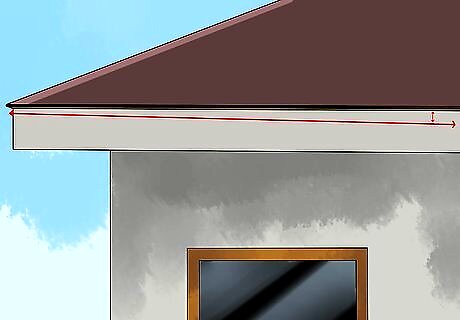
Find the end point of the gutter run by using a 1/2-inch (.635 cm) downward slope. Starting at your high point, move down 1/2-inch for every 10 feet (3 m) of gutter. For example, if you're working on a 25 foot (7.6 m) fascia board, your end point will be roughly 1-1/4 inch below your high point.

Snap a chalk line between the high and low points. Use a level or a measuring stick to try to get an even line. This will be a guidepost for your gutters, so it helps to be precise.
Sizing, Cutting, and Installing the Gutters
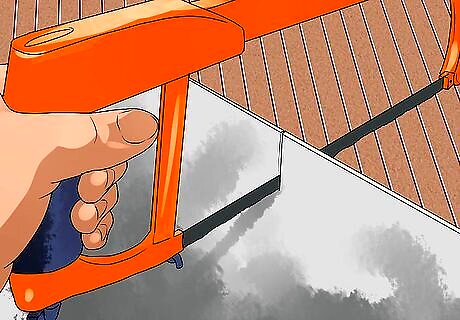
Cut the gutters to size. Use a hacksaw, or heavy duty tin snips to cut the gutter at the appropriate measurement. You may need to cut your gutters at a 45 degree angle if two gutters meet at a corner.
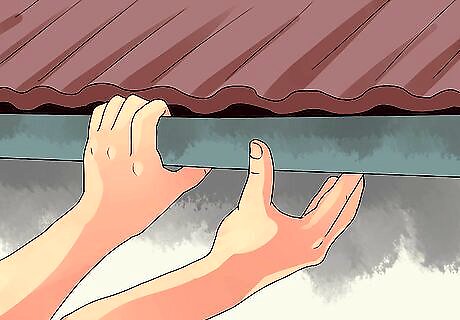
Attach the gutter brackets on every other rafter tail. Locate each rafter tail — usually spaced every 16 inches (40.6 cm) apart — by looking for their signature nail heads. After you've marked the location of each one, drill pilot holes along every other rafter tail to make installation of the brackets easier. Brackets will either snap onto the gutters or will be mounted into the face board first, depending on the type of gutters you purchase. Review the manufacturer's recommendations for your particular type of gutter.
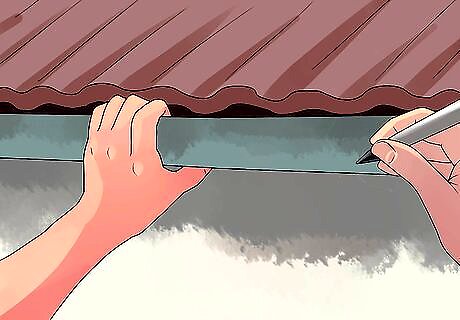
Mark the location for the downspout opening on the gutter. Use a jigsaw to cut a square opening at the appropriate place in the gutter.
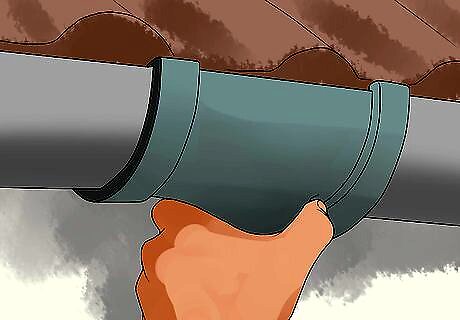
Attach the downspout connector and end cap to the gutter using silicone sealant and short metal screws. An end cap should be used on any open-ended run of gutter.

Mount the gutters. Slip the gutter into place by tilting it upward until its back end fits into place at the top of the bracket. The gutter should either snap into place or be reasonably snug. A bracket should be mounted to the face-board every 18 to 24 inches (45 to 60 cm). Use a stainless steel lag screw long enough to penetrate the face-board at least 2 inches (5 cm).
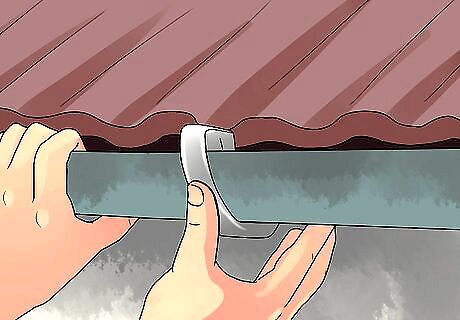
Wrap a thin aluminum strip around the underside of each gutter corner, riveting it into place. To keep water from leaking through small cracks or openings at conjoined corners, insulate the aluminum strip further using waterproof caulk. This aluminum strip can be spray-painted ahead of time to blend in seamlessly with the color of the gutter. Make the strip long enough to extend an inch or two beyond the top of the gutter. Cut a triangular shape into the top of the extending strip, and then fold each corner or the strip over onto the top of the gutter, creating a clean look.
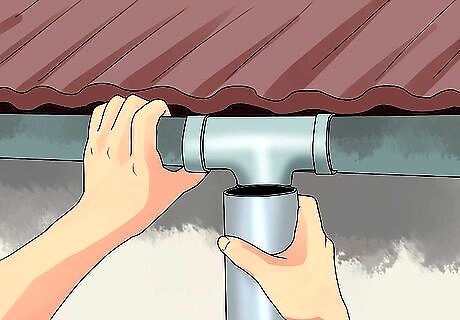
Attach the downspout to the gutters via the downspout connector. Make sure that the tapered end of the downspout is facing down and aimed in the appropriate direction. To get the downspout to connect with the outlet tube, crimp the downspout with some pliers. Fasten the downspout to the gutters and the downspout to the outlet tube either with pop rivets or the appropriate screws.
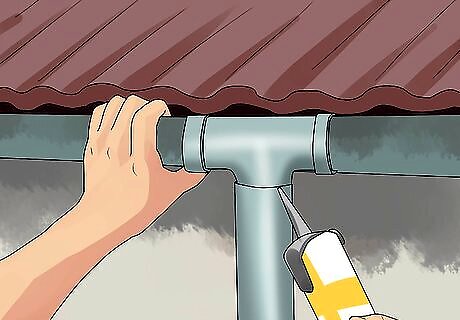
Seal any gutter connection seams with a heavy bead of sealant and allow to dry overnight. Take 100% silicone that is rated for exterior, not interior. Silicone the gap or the joint between the fascia board and where the gutter meets it. This will ensure that any water running onto the fascia from the roof runs into the gutter.
















Comments
0 comment